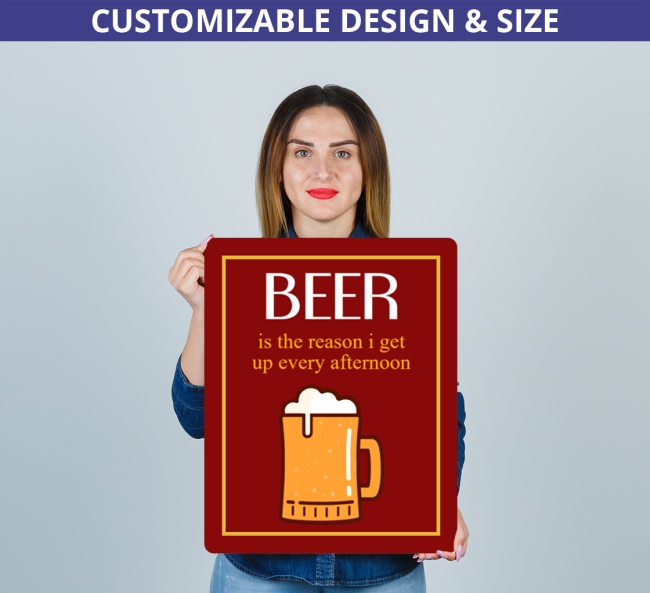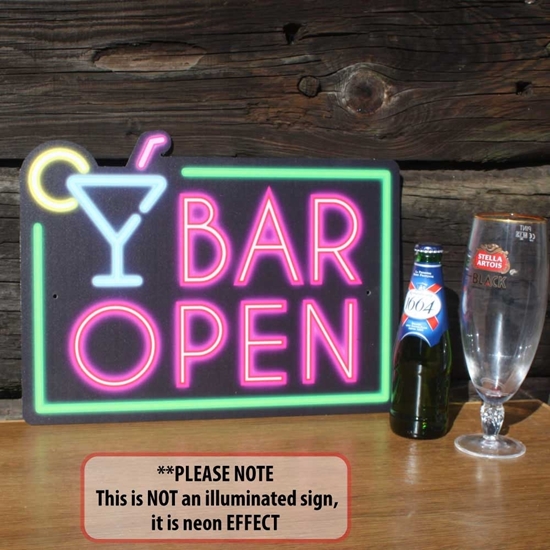Excellent Reasons On Deciding On Pub Signs
Excellent Reasons On Deciding On Pub Signs
Blog Article
What Distinguishes Bar Signs From One Another In Regards To Their Function?
The purpose of bar signs can vary significantly. There are some important differences between bar signs. Branding
Purpose: To create and strengthen the brand identity of the bar.
Features: Often includes the bar's logo, name, and the signature colors. The theme of the bar and its overall vibe should be reflected in the style.
Custom-designed metal signs with the bar’s name and logo.
2. Information
The purpose is to inform customers on the bar.
Highlights: Clear and easy to read text that conveys important details such as opening hours, Wi Fi passwords for the home, rules of conduct, or the location of bathrooms.
Examples: Signs on the entrance indicating hours of service and signs that point towards restrooms.
3. Design
Goal: To enhance the visual appeal of bar.
Features: Adds to the overall decor of the bar. The bar is usually more artistic and thematic. The bar may not have text or specific details.
Examples: Vintage ads for beer, posters with a an edgy or funny theme, themes in artwork.
4. Promo Coupons
Purpose: To promote specific products such as events, specials, or products.
Features: Design that is eye-catching, and highlights special events, offers, or menu items. Use movable or temporary elements.
Examples: Chalkboards with daily deals, banners that advertise happy hour deals posters to advertise upcoming events.
5. Directional
Scope: To direct patrons within the bar.
Highlights: Clear arrows or instructions for customers to navigate the bar, for example, getting to the bathrooms, exits or different sections within the bar.
Examples: Arrows with directions for different seating areas, signage pointing towards restrooms and exits.
6. Regulatory/Compliance
Purposes: To comply with all legal requirements and to make sure that the safety of our employees is maintained.
Highlights: Signs necessary to fulfill legal obligations like smoking areas such as occupancy limits, smoking areas or emergency exits.
For example, "No Smoking", "Occupancy Limit" and "Emergency Exit" signs.
7. Interactive
The goal is to engage customers and create an engaging experience.
Features: Elements to encourage patron involvement, such a writing-on surface or interactive digital elements.
Examples include chalkboards for displaying customer messages or signs with QR codes leading to menus that are digital.
8. Thematic
The aim of the theme is to create a mood or an atmosphere. particular mood.
Signs that are in line with the overall theme or style of the bar. This adds to the overall feel and experience.
Examples: Pirate themed signs in the nautical bar and rustic wood signs the country bar.
9. Menu
Use for: Shows the bar menu.
Features The list of beverages and food items is displayed clearly, typically with prices. The list can be changed or static.
Examples: digital screens that rotate menus as well as the wall-mounted drinks menus.
Every bar sign serves specific functions, and it is made to blend into the bar's atmosphere. When they understand these distinctions, bar owners can decide on and position signs efficiently to increase the enjoyment of customers and satisfy operational requirements. See the best read more here for bar hanging sign for blog tips including personalised beer sign, garden bar signs, make your own bar sign, hanging bar sign, personalised sign for bar, personalised pub signs, personalised home pub sign, personalised beer sign, bespoke bar signs, pub bar signs for sale and more.
What Is The Difference Between Installing And Mounting Bar Signs?
The type of bar sign, its dimensions, its weight, their place of installation, and their use will determine how it's mounted and put up. Here is a look at how to mount and install bar signs. Wall-Mounted Signs
The main characteristics are that it is fixed directly to walls.
Methods:
Anchors and screws are typically employed for signs that are heavy (metal or wood) to give stability.
Adhesive strips are ideal for temporary and lighter installations (acrylic and foam board, acrylic).
Brackets are used to hold signs visible from walls for better visibility.
Uses: Indoor decor, menu boards, directional signs.
Benefits: Safe and flexible display.
The drawbacks of this product are that It may damage walls and is hard to install.
2. Signs that hang from the ceiling
Suspended or hung from ceilings.
Methods:
Chains are sturdy and movable. Perfect for signs that are heavy.
Cables: A sleeker appearance that is frequently utilized in modern designs.
Rods: Provide a rigid support structure.
Uses: Ceiling decor, directional signs, overhead promotional signs.
Advantages: Highly visible, utilizes vertical space, and is a decorative option.
Disadvantages
3. Signs that stand alone
Specifications: Not tied to any other structure, but supported by a stand or a base.
Methods:
A-Frames: Portable and foldable frequently used for sidewalk advertising.
Pedestal Stands: Stable base, ideal for indoor use.
Post and Panels: Usually employed for longer-lasting, more substantial signs.
Uses: Outdoor advertising, indoor directional signs, promotional displays.
Benefits: It is easy to move, portable, and adaptable.
Disadvantages
4. Window Signs
Characteristics: Attached straight to windows.
Methods:
Suction cups: Simple to remove, install and suitable for lighter signs.
Adhesive Film: This material is directly applied to the glass and can be used to create graphics or decals.
Static cling is reusable adhesive that is non-permanent and simple to remove or apply.
Uses: Promotional messages and branding.
Benefits: The most windows and extremely visible from outside.
Window size limitations and light levels can affect performance.
5. Signs with Edge and Backlit Lighting
Features: Include lighting into the sign's structure.
Methods:
Wall Mounting With Electrical Connections. This requires electrical connections and an appropriate attachment.
Suspended with Power Cables Hanging method and integrated lighting.
It can be used for branding with high visibility for menu boards as well as decorative elements.
Benefits include improved visibility and attractive lighting.
Installation is more difficult and requires electricity.
6. Portable and Temporary Signs
Features: Designed for simple setup and removal.
Methods:
Pop-Up Stands: Lightweight and collapsible.
Banner Stands: Roll-up or retractable designs.
Uses : Events, promotions and seasonal decorations.
Fast and simple setup.
Disadvantages: Less durable, may not be as stable.
7. Magnetic Signs
Specifications: Attach using magnetic force.
Methods:
Magnet Strips: They are applied to the backside of the sign.
Magnetic Boards: Sign attaches to a surface made of metal.
Uses For: Temporary notices, menu boards that can be changed.
Advantages Easy to change. No permanent fixtures required.
Advantages: Limited to magnetic surfaces, can be less secure.
8. Projection Signs
Make use of light to show a text or image.
Methods:
Mounted Projectors: Securely anchored on ceilings or walls.
Portable projectors can be positioned on stands or other surfaces.
Displays that are dynamic for events, promotions and other promotional activities.
Advantages: It is easy to change the content and no physical sign is required.
Disadvantages
The importance of mounting and installation
Size and Weight
Heavy Signs: These signs require stronger options for mounting, like anchors and screws.
Light Signs can be created with less complex methods, like suction cups or adhesive strips.
Durability
Permanent Signs: Choose an easier and more durable mounting method.
Temporary Signs - Choose one that permits simple removal and repositioning.
Location
Indoor: Less concern with weather resistance, greater flexibility of materials and methods.
Outdoor: The materials and the mounting have to be weatherproof to endure the elements.
Aesthetics
Concealed Mounting gives a neat appearance by concealing all hardware.
Decor Hardware: Improves the appearance of the sign.
Accessibility
Easy Access for Changes It is particularly important for signage, such as menu boards that need frequent updates.
Security: Make sure signs can't be easily tampered or stolen.
By considering these factors the bar owners can select the appropriate mounting and installation methods that are most suitable for their needs. This will ensure that the security of their signage visible and line with their bar's aesthetic and functional requirements. See the top her latest blog on make a pub sign for more advice including personalised garden pub sign, buy bar signs, large personalised bar signs, hanging tavern sign, home garden bar signs, bar hanging sign, personalised outdoor bar signs, hanging home bar signs, hanging pub signs for sale, personalised hanging bar sign and more.
How Do Bar Signs Differ In Terms Of Branding?
The sign for the bar is a key element of branding since it communicates the style the personality, character and identity of the establishment to its patrons. What are the distinctions between logos and bar signs? Logos and Brand Identity
Logo Integration: Incorporating the bar's logo prominently onto signage can help build brand recognition and enhance the reputation of the establishment.
Consistent brand: To maintain the consistency of branding, signs must match other branding elements, like coasters, menus, and the social media pages.
2. Visual Style Design
Thematic Design: Signs express the theme and atmosphere of a bar, regardless of whether it's a cozy pub, stylish lounge, or lively nightclub.
Custom Graphics: Graphics, typography and imagery that are unique can differentiate your business and entice customers.
3. Color Scheme
Branded Colors. The use of a bar's signature colors on the signage can assist in strengthening the brand and help create a consistent brand.
Contrast, legibility and readability Colors can be selected to ensure brand consistency, as well as for readability under various lighting conditions.
4. The tone of the message
Brand voice: Signs express the character and tone of the establishment by delivering messages. It could be fun or lighthearted, elegant, sophisticated or bold.
Slogans and taglines. Catchy taglines or slogans can help reinforce the message of your brand and leave an impression on customers.
5. Positioning of signs and visibility
Signage placement: The signs are strategically placed to increase their visibility whether at the entrance, in the bar, or throughout the venue.
Size and Scale. Larger signs grab the attention of passers-by and create bold statements, while smaller signs offer subtle branding cues for more intimate areas.
6. Specialty Signage
Signage: Customized signage such as neon signs or chalkboard menus can enhance the character of a bar and reinforce its brand identity.
Interactive Elements Signs featuring interactive features like QR codes or digital options can enhance customer experience and improve brand awareness.
7. Brand Storytelling
History and Heritage The signs may include elements of the bar's past and location, as well as the founder's story to give a feeling of authenticity and connection to patrons.
Unique Selling Points Highlighting distinctive offerings, signature cocktails, and other features in the signage can help increase the value of your bar's brand. It will also encourage customers.
8. Branding for Promotions and Seasonal Events
Holiday Themes: Christmas decorations and themed signs are a reflection of the bar's festive atmosphere and create a memorable evening for customers.
Promotional signage that advertises special events like happy hours or limited-time deals can boost sales.
9. Customer Engagement
Users-generated Materials: Allowing patrons to upload pictures of your signage on social media platforms can help you reach a wider crowd and help build a stronger feeling of community.
Interactive Signage: Signs which invite patron participation like chalkboards to draw on, or photo booths to capture selfies are memorable and strengthen the brand affinity.
10. Digital Branding
Digital Signage: Interactive screens LED screens, digital menus work well for branding because they allow real-time updates and animations.
Online Presence - QR codes or handles for social media are placed on signs to increase engagement on the internet. They allow patrons to be connected with a bar's presence and make it more accessible.
Bar owners can use signs to promote their brand identity and engage customers. They can also use signage to distinguish their establishments from others in a highly competitive marketplace. Follow the top rated official source on home pub signs for more examples including gin bar sign, pub signs made, bar signs, bar signs for home bar, outdoor personalised bar sign, pub signs, garden bar sign personalised, large pub sign, personalised garden pub sign, sign for garden bar and more.